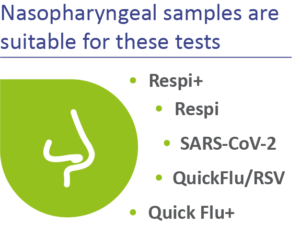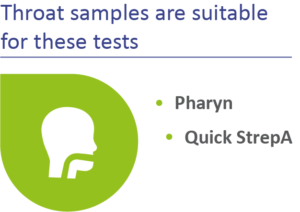
Sampling


Why sampling is very important?
- The accuracy of rapid tests and especially sensitivity is highly dependent on the quality of sampling and the time from onset of the symptoms
- The diagnostic test result is only as good as the quality of the sample
- To detect respiratory infection pathogens, sampling should be done during viremia within six days from the onset of symptoms. Most preferably it should be done within five days. Viral titres go down in due time and usually viral antigens are no longer detectable after 6‒7 days. Maximum amount of virus is typically present on days 1‒3.
Nasopharyngeal samples
Sampling procedure
- Ask the patient to blow their nose when possible
- Bend the patient´s head backward
- Swiftly insert the swab into the nostril. The depth of insertion is around 4–8 cm for children and 8–12 cm for adults.
- Rotate the swab against the nasopharyngeal mucosa and remove the swab
Sample pretreatment
Nasopharyngeal swab
- Take a sample from the nasopharynx with a flocked swab and insert the swab into a test tube
- Dispense sample buffer and vortex
- Insert the barcoded test tube into the analyser for automated analysis
Respi test procedure for nasopharyngeal swab samples
Nasopharyngeal aspirate
- Suitable for lab testing
Nasal samples
- Ask the patient to blow their nose when possible
- Bend the patient´s head backward
- Insert large rigid swab into the nostril and rub the nasal cavity. The swab should be inserted deep enough, 2-3 cm depending on the size of the nose.
- Rub with a rotational motion at least five times so that the cells from the mucosa adhere to the swab.
- Repeat the above-mentioned procedure in the other nasal cavity with the same swab.
Check out our video about nasal sampling.
Throat samples
Sampling procedure
- Press the tongue down with a spatula or hold it with fingers and gauze
- Wipe the swab back and forth across the oropharynx and the tonsils to obtain an adequate sample
- Ensure that the sample is not contaminated by the normal flora of the mouth by avoiding contact with other surfaces, such as the tongue and cheeks
Sample pretreatment
- Take a sample from the throat with flocked swab and insert the swab into a test tube
- Add extraction solutions A and B, vortex and incubate 2-10 minutes
- Dispense sample buffer and vortex
- Insert the barcoded test tube into the analyser for automated analysis
Stool samples
Sample pretreatment
- Suspend stool sample into Gastro Sample Buffer
- Filter the sample directly into barcoded mariPOC® test tube
- Insert the test tube into the analyser for automated analysis
Sample pretreatment for mariPOC® Gastro and CDI tests
Flocked swabs recommended for sampling
- Only flocked swabs are recommended for sample collection. Further information can be found from User’s manual and local representatives.
- Considering the patient size, choose as large swab as possible in order to obtain high quality sample